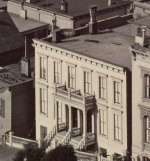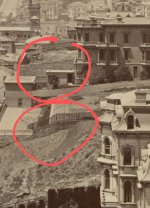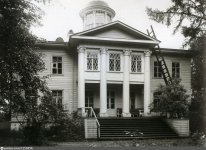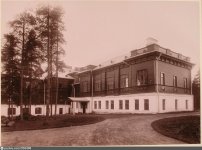On 11 July 1877, Eadweard Muybridge (1830-1904) announced in the San Francisco Bulletin the publication of a “Panorama of San Francisco from California Street Hill.” The photographs were taken from the tower of the Mark Hopkins mansion, then the highest point in San Francisco, 116 metres (381 feet) above the harbour, which commanded an uninterrupted, sweeping view of the entire city, its harbour, and San Francisco Bay. One year later, Muybridge re-photographed the view, as seen here.
KD note: I wanted to get this out of the way real quick. This city is not 100% abandoned. Its population in 1880 was supposed to be 234 thousand people. This high quality image allowed me to spot like may be 50-70 people, and about as many horse buggies. Yet, when you fully comprehend the size of this "30 y.o." city, 234k will sound unreasonable. It was supposed to have at least four times that, IMHO.

I think the story of San Francisco is very similar to the one of Saint Petersburg. Points of discussion I would like to offer:
The history of San Francisco effectively started in 1848. Wikipedia mentions 1776, but this date is irrelevant for our investigation. Here is why.
We are only concerned with the range of 1848 - 1880, because the photograph in question was allegedly made in 1878.
First of all, I have a feeling that we are looking at a roof of a buried building. Then we have this little red arrow I put in there. Is it a wire it is pointing at? If it is a wire,what could it be for?
I'm wondering who could see this weather vane from the ground? What if it was mounted that high for a different purpose?

Construction EquipmentThis is what they built this city with, I guess...

KD: Anyways, I just wanted to see what your opinion on these photographs was. Something is not right about all of this.
KD note: I wanted to get this out of the way real quick. This city is not 100% abandoned. Its population in 1880 was supposed to be 234 thousand people. This high quality image allowed me to spot like may be 50-70 people, and about as many horse buggies. Yet, when you fully comprehend the size of this "30 y.o." city, 234k will sound unreasonable. It was supposed to have at least four times that, IMHO.
- This city appears to be dead. No chimney smoke, no day to day activity, no nothing... just the void of emptiness.
1878 Panorama of San Francisco
I ran into a website which has a crazy size version of this panchromatic photograph. In my opinion the photographs reveal way too much, and I wanted to offer our blog members to do a thorough investigation of this photograph. This 1878 resolution should probably be illegal.- Panorama of San Francisco from California-Street Hill
- If you understand the narrative, this 30 year old city will blow your mind.
- You will have to zoom in and really pay attention.
- Additional source to consider.
- History of this panoramic photograph
I think the story of San Francisco is very similar to the one of Saint Petersburg. Points of discussion I would like to offer:
- This city does not look brand new, and has no signs of any serious construction development.
- It was impossible to build what you see in the photograph within 30 years, with what they had.
- California Gold rushers of 1848-1855 were indeed digging for "gold", with gold being the city of San Francisco itself.
- I think they were digging San Francisco out of the mounds of dirt.
- Multitude of strange "little things". This photograph has quite a few to offer.
- Could the buildings of the future 1915 SF Expo be buried underneath some of the hills?
The history of San Francisco effectively started in 1848. Wikipedia mentions 1776, but this date is irrelevant for our investigation. Here is why.
We are only concerned with the range of 1848 - 1880, because the photograph in question was allegedly made in 1878.
Gold Rush
The California Gold Rush (1848–1855) began on January 24, 1848, when gold was found in Coloma, California. The news of gold brought approximately 300,000 people to California from the rest of the United States and abroad.- San Francisco grew from a small settlement of about 200 residents in 1846 to a boomtown of about 36,000 by 1852.
- If they were digging for gold - who built the city?
- If they were building the city - who was digging for gold?
1915 Exposition
Below we have two differently dated visual representations of the famous Palace of Fine Arts. It was allegedly built out of horse hair and plaster, aka staff, for the 1915 Panama-Pacific International Exposition. The date of 1915 at first glance appears to have nothing to do with 1878. Yet, if the Expo structures were simply restored using previous architecture, the relationship between 1878 and 1915 could be a bit more obvious.- Top Painting: dated - 1915. Edwin Deakin oil on canvas painting by and titled "Palace of Fine Arts and the Lagoon".
- Bottom Photo: dated - 1919. A panorama of the Palace of Fine Arts c.1919.
- The current building was rebuilt in the 1960s
- Palace of Fine Arts - Wikipedia
- While the Palace had been saved from demolition, its structure was not stable. Originally intended to only stand for the duration of the Exhibition, the colonnade and rotunda were not built of durable materials, and thus framed in wood and then covered with staff, a mixture of plaster and burlap-type fiber. As a result of the construction and vandalism, by the 1950s the simulated ruin was in fact a crumbling ruin.
First of all, I have a feeling that we are looking at a roof of a buried building. Then we have this little red arrow I put in there. Is it a wire it is pointing at? If it is a wire,what could it be for?
I'm wondering who could see this weather vane from the ground? What if it was mounted that high for a different purpose?
Weather Vane

Are those flower bed type thingies?

Source
Atmospheric Electricity?

Source
Churches and Cathedrals
This one is out of curiosity. How many churches, and cathedrals can you count in this 1878, 30 year old city of San Francisco?Are those flower bed type thingies?
Source
Atmospheric Electricity?
Source
Churches and Cathedrals
Construction Equipment
KD: Anyways, I just wanted to see what your opinion on these photographs was. Something is not right about all of this.
- I'm wondering how much of this 1878 San Francisco did not get into the photo due to being behind the photographer.
- Also, what do you think about the future expo buildings being possibly buried in the dirt?
- Where are the people?
- Where are all horses?





